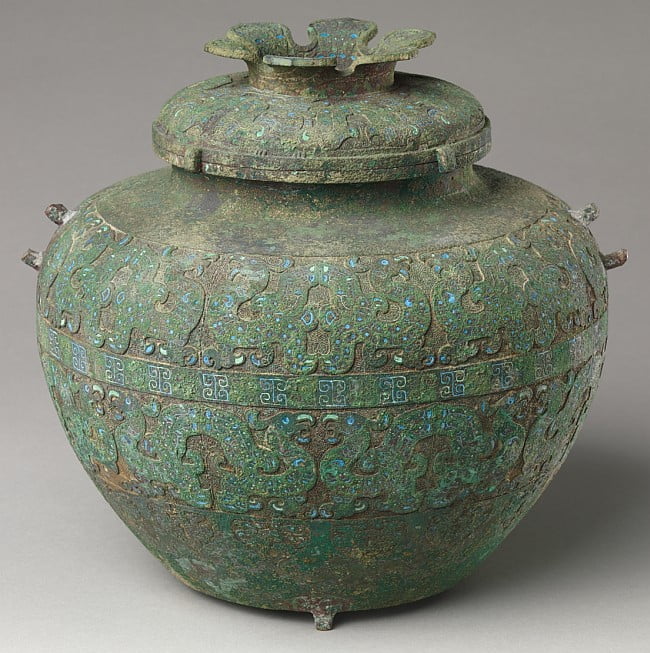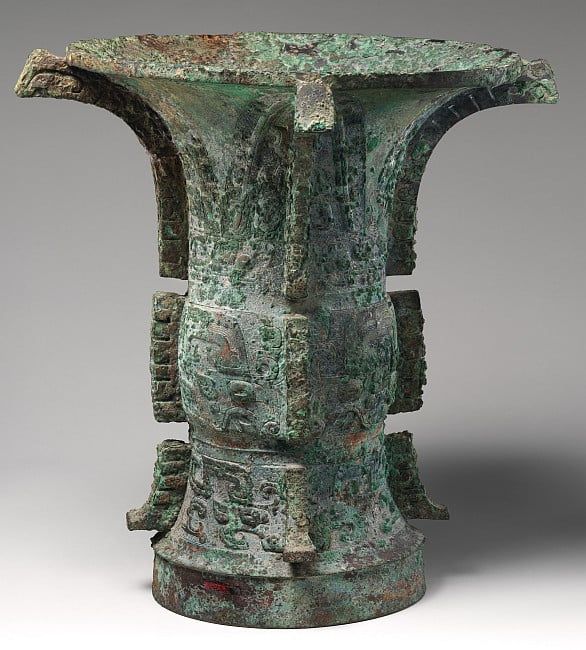Introducing the 缶 fou jar
Here’s another character that occurs just three times in the Yijing: fou 缶. This is a vessel for holding liquids, something like an amphora, with a narrow neck and large body.
It’s originally a pottery jar – that’s the first meaning of the character – but was also made in bronze. And from early times, according to Wikipedia, it was also a percussion instrument used in ritual.
There are three of these jars in the Yijing (the italicised word in each line):
‘With truth and confidence, seeking union,
Hexagram 8, line 1
No mistake.
With truth and confidence to overflow the vessel
An end comes – further good fortune.’
‘A cup of wine, a pair of dishes,
Hexagram 29, line 4
Using earthenware.
Let in with ropes from the window.
In the end, no mistake.’
‘In the clear light of the setting sun,
Hexagram 30, line 3
If not beating a pot and singing,
Then you will be making the lament of great old age.
Pitfall.’

8.1
‘With truth and confidence, seeking union,
No mistake.
With truth and confidence to overflow the vessel
An end comes – further good fortune.’
The ‘overflowing vessel’ is 盈缶, ying fou. Ying itself shows an open bowl with something above it, maybe ‘success’; it means full, surplus, satisfy. So here is a wine jar full of truth: all the truth concentrated and stored up in one place, like the energetic growing centre of the zhi gua, Hexagram 3.
In vino veritas, perhaps – or just an exceptionally beautiful image of the overflowing mutual confidence at the root of our desire to be together and sense of belonging. Start as you mean to go on, and it’ll end well.
29.4
‘A cup of wine, a pair of dishes,
Using earthenware.
Let in with ropes from the window.
In the end, no mistake.’

The fou here is translated ‘earthenware’ – translators generally agree on this. I wonder, though, whether it might not work better to pass wine in through the window in a fou, with its handles and narrow neck, and then pour it out into the wine-cup. It’d be hard to pass a zun cup without spilling the wine it contained.
So fou here means simplicity – just earthenware will do the job, no need for anything ornate – and perhaps also practicality, handling liquids. (After all, Hexagram 29 is made of the doubled trigram for running water.) How do you get the wine in through the window? ‘On its way’ or ‘available’ is not the same thing as safely arrived – this much is clear from other, connected lines (47.4, 48.3). There’s many a slip ‘twixt cup and lip.
An aside: I think this line may be riffing on the shape of the hexagram. There’s an open ‘window’ of yin lines 3 and 4 with a ‘window frame’ of yang lines 2 and 5 – and these four inner lines unfurl into the nuclear hexagram 27, Nourishment.
30.3
‘In the clear light of the setting sun,
If not beating a pot and singing,
Then you will be making the lament of great old age.
Pitfall.’
Here the fou is the pot to beat on while you sing. A fou has two distinct uses: it can be full of liquid, or it can be empty and used as a drum. And 30.3 is a very empty line: not much daylight left, not much time left, and also not much human companionship. When you reach a ‘great old age’, most of the people you know are dead – that’s true enough now, but the experience must have been more marked in a smaller community.
So if you have no-one to drink with, empty out the wine jar and make a drum of it. And since the fou is a percussion instrument for use in ritual, this isn’t just about making a cheerful cacophony with the saucepans, but honouring the spirits of the deceased. The music of your fou drum may ‘bite through’ (zhi gua 21) the obstacle that separates you.
Conclusions?
Is this a deliberately significant group of three, or just coincidence? I think there are signs it’s deliberate. For one thing, the two states of this jar, full and empty, correspond to the trigrams of the three hexagrams: a full jar has liquid contained within earthenware :|: ; an empty one contains space within its solid walls |:| .
Also, the three lines share and develop a theme. In 8.1, the jar brim-full of trust is the very beginning of ‘Seeking Union’ – of people belonging together. In 29.4, the jar let in through the window is part of making a connection, overcoming the isolation of the zhi gua 47. And 30.3 can be about overcoming loneliness. Wine vessel or drum, the fou is about deep connection.
I Ching Community discussion










This discussion of 8.1 caused me to see something..
it as a guide for marriage vows:
“With truth and confidence seeking union – no mistake”
Vowing to be of strong mind and are entering the union voluntarily.
“With truth and confidence to overflow the vessel an end comes – further good fortune.”
God’s promise that when two people share a union of truth and confidence their cup of blessings runs over and when their earthly lives come to an end they will go on to even greater happiness in the here after.
🙂
So beautiful is your vision, always Rosada
Now I’m looking at 29.4 with it’s emphasis on how a bit of simple refreshment can transform an abyss. It reminds me of the poem by Omar Khayyam:
A book of verses, a jug of wine, a loaf of bread underneath – and thou
Beside me singing in the wilderness –
O Wilderness were Paradise enow!
30.3
thank you for the explanation… it´s spot on…